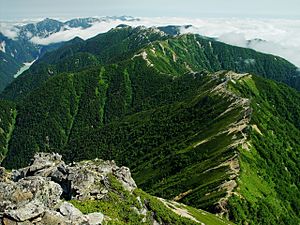Ridge facts for kids
A ridge is like a long, raised line of land, often made up of a chain of mountains or hills. Imagine a giant wrinkle on the Earth's surface! These ridges can stretch for many miles, forming many peaks along the way. People often call them hills or mountains too, depending on how big they are.
Contents
What Makes a Mountain Ridge?
Mountain ridges are amazing natural features. They are usually formed by powerful forces deep within the Earth or by the slow work of erosion. Erosion is when wind, water, or ice slowly wear away the land.
How Ridges Are Formed
Ridges can form in a few different ways. One common way is through the movement of tectonic plates. These are huge pieces of the Earth's outer layer. When two plates push against each other, the land can fold and lift up, creating long lines of mountains and ridges.
Another way ridges form is through erosion. Imagine a river cutting through a flat area. Over millions of years, the river might carve out valleys, leaving the harder rock standing tall as ridges. This is often how you see ridges in places like the Appalachian Mountains in North America.
Different Kinds of Ridges
Ridges come in many shapes and sizes. Some are gentle and rounded, while others are sharp and jagged.
Arêtes: Sharp Ridges
An arête (pronounced "uh-RET") is a very narrow, sharp ridge. These often form in mountain areas where glaciers have carved out valleys on both sides. The glaciers act like giant scoops, leaving only a thin, knife-edge ridge between them. The Koncheto ridge in the Pirin Mountains is a famous example of an arête.
Stratigraphic Ridges
Some ridges are called stratigraphic ridges. These form when layers of rock (called strata) are tilted or folded. If some rock layers are harder than others, the softer layers erode away more easily. This leaves the harder, more resistant rock standing up as a ridge. The Appalachian Mountains have many examples of these types of ridges.
Tuya Edges
A tuya (pronounced "TOO-yah") is a flat-topped, steep-sided volcano. These volcanoes form when lava erupts under a thick glacier or ice sheet. The edges of these flat-topped mountains can also form ridge-like features.
Where Ridges Are Found
You can find ridges all over the world, from small hills to massive mountain ranges. They are a common sight in places with a lot of geological activity or a long history of erosion.
For example, the Pyynikki Ridge is a well-known ridge in Tampere, Finland. It's a popular spot for people to visit and enjoy nature. Many large mountain ranges, like the Himalayas or the Andes, are made up of many interconnected ridges.
Why Ridges Are Important
Ridges are important for many reasons. They can affect weather patterns, guiding winds and influencing where rain falls. They also create unique ecosystems and habitats for different plants and animals. Many animals rely on ridges for shelter or as migration routes.
For humans, ridges can be important for recreation, like hiking and climbing. They can also act as natural barriers, influencing where towns and cities are built.
Images for kids
-
The edges of tuyas can form ridges.






